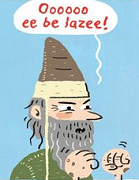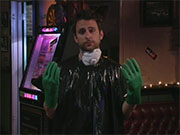|
Qwijib0 posted:I don't know that it's constant, based on the couple blurbs I've read it varies by time of day and traffic counts. That sounds about right. Later at night with no traffic I can usually get from Swan to Country Club without stopping on Ft Lowell.
|
|
|
|

|
| # ? May 25, 2024 08:39 |
|
Cichlidae posted:I LOVED the 75mph rural roads. It was like being in France again. Sure, you have a ton of head-on fatalities, but I'd be willing to wager that from a cost-benefit perspective, it's not worth widening them and slapping down a median unless the ADT breaks 10,000. Unlike when I was in Nebraska, the part of the state I was in actually had some topography, so you didn't get highway hypnosis as badly. Yeah, if you can keep from suffering highway hypnosis (I don't drive at night for that very reason) the high speed roads are pretty good. TxDOT and the Highway Patrol realize that there's a lot of nothing between point A and B and there's no reason to really linger in between. Of course you do have to watch out for the speed traps that every single small town becomes when that 75mph road becomes said small town's main street. TxDOT knows how to build and maintain roads very well, and it's got the rural stuff down to a science. It's in the big cities that everything gets horrible. I'm not kidding about how bad I-35 through central Austin is, and that was before the construction (as I said it's needed but it's definitely not making things easier in the meantime). But hey, our segment of I-35 at least has wings! That has to count for something...right?  (After all these years I still can't decide if that's a really cool or really stupid way to light a parking lot below an overpass)
|
|
|
|
I'll see your wings and raise you faux brick structure.
|
|
|
|
Speaking of road facings, is there a name for this pattern/style of interlocking things, and is there any particular reason it gets used? The street view link is here if that helps https://www.google.com/maps/@39.9570726,-75.1431056,3a,75y,200.5h,80.33t/data=!3m6!1e1!3m4!1sR7pGND5OMMh6xNhQQv8o6g!2e0!7i13312!8i6656
|
|
|
|
It's called an MSE (mechanically stabilized earth) or Reinforced Soil structure. The earth fill bears the load, while the precast interlocking wall panels keep the earth in place.
|
|
|
|
Varance posted:I'll see your wings and raise you faux brick structure. Wow...that's just...pathetic. I guess it does make sense that something that tacky would exist in Florida. fishmech posted:Speaking of road facings, is there a name for this pattern/style of interlocking things, and is there any particular reason it gets used? Probably because it's a cheap, stable tessellating shape. I watched a highway overpass be torn down and rebuilt near my old apartment over a couple years and they had concrete forms (not those shapes but another similar one) sitting out. I'm pretty sure they're just a standard prefab piece that's either made by the city/state themselves or bought from a factory and shipped to site. Varance posted:It's called an MSE (mechanically stabilized earth) or Reinforced Soil structure. The earth fill bears the load, while the precast interlocking wall panels keep the earth in place. what he said.
|
|
|
|
Must be a state produced Standard panel then, because I've only seen that particular pattern on roads in Pennsylvania.
|
|
|
|
Eh, I've seen that shape all over the place in Texas. Though TxDOT seems to be branching out as a lot of the newer panels have fancier ones. Some have Texas states or flags on them, some fit together to form a mural.
|
|
|
|
We occasionally get creative with our panel walls in Florida. Most of our common stuff is done in a faux-limestone look. Closer to downtown Tampa, we've got faux brick, painted red. Down by the port of tampa, the panel walls were designed to look like shipping containers. This is from the new, rebuilt version of the first SPUI ever built (US19 @ SR60 in Clearwater, FL). Sometimes, when you have over 150,000 cars going through an intersection daily, even a SPUI isn't enough.  Google Street View: https://www.google.com/maps/@27.9604758,-82.7292678,3a,75y,278.12h,77.88t/data=!3m6!1e1!3m4!1swTXHlKAs5g3HU6qxbTbBHQ!2e0!7i13312!8i6656 Varance fucked around with this message at 05:29 on Dec 10, 2015 |
|
|
|
Varance posted:Intersections next to railroad crossings typically go green for the road the rails cross right before or as the gates come down, as to get people off of the tracks quicker. Okay, I can accept that. Qwijib0 posted:The city of Tucson is big enough to need ITS, and small enough to afford it. Shamelessly stolen from their summary page Varance posted:It's called an MSE (mechanically stabilized earth) or Reinforced Soil structure. The earth fill bears the load, while the precast interlocking wall panels keep the earth in place. 
|
|
|
|
Qwijib0 posted:Owns Also quoting this as a post that was great and super interesting thank you. You also have a very good username.
|
|
|
|
Happy Noodle Boy posted:I just "finished" a railroad crossing resurfacing as part of a bikeway path connector project. The railroad was a nightmare to work with. They're a nightmare to work with even if you're not directly involved with a project. An intersection that I use everyday was recently redone that happens to be next to a grade crossing. When the construction started back in June the traffic lights were put into conflict mode and eventually replaced as part of the project. The project was completed in September and yet the brand new lights are still in conflict mode today. When I contacted the city engineers they told me that they're waiting on the goddamn railroad to get around to re-linking their crossing signals with the new light. No estimated completion date is available. Might as well have saved the taxpayers some money and put up stop signs instead. PremiumSupport fucked around with this message at 18:21 on Dec 14, 2015 |
|
|
|
Restraint Key posted:When I contacted the city engineers they told me that they're waiting on the goddamn railroad to get around to re-linking their crossing signals with the new light. No estimated completion date is available. Might as well have saved the taxpayers some money and put up stop signs instead. Alternatively: Close the intersection to rail traffic until they can find time to make the intersection functional and safe. 
|
|
|
|
Kaal posted:Alternatively: Close the intersection to rail traffic until they can find time to make the intersection functional and safe. God, I wish we could do this to utilities when they hold up the project. "Sorry, you didn't move your poles in time, so we bulldozed them. Maybe next time you should stick to the schedule."
|
|
|
|
Kaal posted:Alternatively: Close the intersection to rail traffic until they can find time to make the intersection functional and safe.  I can't imagine how much trouble we would get pulling a stunt like this. I can't imagine how much trouble we would get pulling a stunt like this.
|
|
|
|
Happy Noodle Boy posted:
Just write a letter to a local newspaper, or better yet, a small local TV station. "This intersection is dangerous, because these dumb-dumbs won't let us coordinate the traffic signal and rail crossing signal properly" A reporter that has nothing else to do would eat that poo poo up. will_colorado fucked around with this message at 23:24 on Dec 14, 2015 |
|
|
|
Right but railroads aren't like any other. They have the legal right to basically give no fucks to any city authority. Their customers are all other huge corporations so they don't really care or depend on public good will. Railroads are unstoppable monsters.
|
|
|
|
Baronjutter posted:Right but railroads aren't like any other. They have the legal right to basically give no fucks to any city authority. Their customers are all other huge corporations so they don't really care or depend on public good will. Railroads are unstoppable monsters. Options: 1. Declare the crossing to be unsafe and close the crossing to all railroad traffic. 2. Set the municipal speed limit to 1 mph, and halt and arrest any train that violates that limit. 3. Seize the crossing using Eminent Domain. Step 4: Live the rest of your professional life in a circuit court room.
|
|
|
|
Kaal posted:Options: Step 4 should be relabeled "Steps 4 through Infinity". Honestly I'd say the better option really is trying to goad local bored reporters to harassing the railroads. While there's a good chance that little to nothing would happen, it would at least mean that Grandma and her Bingo Club would start sending letters somewhere besides the local traffic engineers.
|
|
|
|
Cichlidae posted:
Man, I need to dig up the safety stats work we did for Florida / I read up on for the literature review phase, because I can't remember the median cost-benefit numbers other than that medians own even with the expense. That said, in rural Texas, it's not like the land is super-expensive, and it's not like medians themselves are all that expensive to maintain.
|
|
|
|
GreyjoyBastard posted:Man, I need to dig up the safety stats work we did for Florida / I read up on for the literature review phase, because I can't remember the median cost-benefit numbers other than that medians own even with the expense. This is true. They have centerline rumble strips, at least, so that probably reduces the crash rate. The B/C ratio on CLRS is ~50:1, and they cost about 25 cents a foot, or about $1300/mile. So the accident cost must be around $65k/mile, right? Rumble strips have a relatively short lifespan (they have to be replaced every time the road is re-paved), whereas medians are there forever. The tricky part might be that your LOS is degraded by not having passing zones. But hey, it's that old safety vs. efficiency argument again!
|
|
|
|
kefkafloyd posted:The scars of unfinished roads also influence this decision; I-290 was supposed to continue from 495 to route 128 in Weston, while I-190 was supposed to continue up through western NH to Manchester, following Route 101. Theoretically, 395/290/190 would then be dubbed as one highway. It's long enough to be its own 2DI, but which one you would use is a tough call. It would probably be dubbed either I-93W or I-91E, even though people hate using suffixed 2DIs. I-86 would be right out due to historical reasons (the 84/86 renumbering was still fresh) and the shuffle that created I-395 in the first place would give I-86 to New York. Oh wow! Thanks for the insight into this. As a fairly new resident of New England (5 years now), I had no idea about any of these plans. The idea of an extended 190 sounds awesome, too bad it will never happen. Speaking of traffic things on my wish list that would never happen: fix Route 2 in Concord to make it freeway all the way (gently caress Concord) and create a decent east/west route from Nashua to 91.
|
|
|
|
Lord Wexia posted:Speaking of traffic things on my wish list that would never happen: fix Route 2 in Concord to make it freeway all the way (gently caress Concord) and create a decent east/west route from Nashua to 91. Crosby's Corner will be done Real Soon Now™ and the Concord rotary's elimination is next up on the docket (ETA 2018-19). Unfortunately, the Route 2 freeway as we would know it today died in the 1970s along with a bunch of other things. There will never be a complete freeway. TBH I don't think there ever would be enough demand to make a freeway out of VT 9/Route 101. They couldn't build the US 2 freeway (I-94 E) across northern VT/ME/NH and that had actual work done in real life before it was killed. If you're bored and want to know more, read my friend Steve Anderson's Boston Roads. Particularly the unbuilt roads section.
|
|
|
|
Presented for thread approval, my attempt at an intersection. The blue is a tram! Any glaring problems? I don't exactly have traffic manuals to follow but I did my best. I also recently read some articles about really bad north american attempts at dutch style intersections basically being cargo-cult and missing the point of the design. I hope at my amateur level I "get" how the intersections are supposed to work, by both providing space for turning cars to sort of half make their turn and stop for a bike/ped but not block traffic and to have the crossing closer to 90 degrees so the driver has the peds/bikes in their front field of view, not in their right blind spot. It also gives bikes waiting for the light a space to wait without blocking bike traffic. The east-west route is the major through route in the area, the road heading south services some major industries so will see truck traffic. North leads to a maze of dutch style access controlled streets mostly designed to keep through traffic out. The bike lanes to the south are the sort of narrow painted-on garbage you'd see in a typical north american city. Wouldn't want to be sharing that road with big-rigs, but it was the only compromise possible even with those narrow sidewalks. It's a street for trucks, the bike lanes and sidewalks were just minimums to check some boxes. Baronjutter fucked around with this message at 00:30 on Dec 18, 2015 |
|
|
|
With my amateur eyes I'd say it mostly looks fine. If the intersection has traffic lights there should be a separate phase for cyclists only, or straight traffic (including cyclists) should have right of way. That means that when the road from the south gets green, cars turning right would have to stop for any northbound cyclists on the right side of the road. That's tricky if drivers aren't familiar with that situation so I'd suggest a separate phase. It's a very good idea to coordinate cycle phases with the walk light for the adjacent pedestrian crossings. If there aren't traffic lights, in the Dutch system, within city boundaries cyclists would have right of way, so cars would have to stop just before the cycle path*. Outside of cities, cars have right of way. There's usually clear signage for that... but Dutch drivers are also very familiar with that system, and I wouldn't be surprised it's hard to understand what you're supposed to do if you've never seen it before. Another thing that concerns me a bit is that tram/bike lane crossing. Cyclists are not used to look behind their back when turning right. If this situation can't be solved in any other way, the Dutch would solve it by having both flashing light and sound signals (bells) for the tram crossing. And for the tram/road crossing it's of course necessary to adjust the traffic lights so no cars try to cross the tram line when a tram is coming through. Edit: * Just realized that for eastbound traffic, that would put them on top of the tram line. That's problematic, especially if you ever get traffic jams further ahead on the eastbound road. Seeing there's not enough space for any other option, I'd suggest to remove the eastern bicycle crossing altogether, and make the western and southern ones two-way. Shouldn't be much of a problem as the northbound bike path doesn't continue on that side anyway. Carbon dioxide fucked around with this message at 10:30 on Dec 18, 2015 |
|
|
|
Baronjutter posted:Presented for thread approval, my attempt at an intersection. The blue is a tram! Looks cool. How'd you make it? Just MS paint and funny line tools or something? I tried doing something similar with a junction near me but couldn't make it looks remotely sane. My one observation would be that pedestrian waiting areas are small, and if you have any significant level of pedestrian traffic they're going to wait in the cycle lanes and cause conflict. Other than that, looks good to my very untrained eye.
|
|
|
|
Baronjutter posted:Presented for thread approval, my attempt at an intersection. The blue is a tram! How do buses and other large vehicles make right hand turns from the north-south road onto the east-west road without going over either the corner with their rear wheels or the small island with their front tires? Seems like a very tight turn without that extra half lane exiting the turn.
|
|
|
|
Baronjutter posted:Presented for thread approval, my attempt at an intersection. The blue is a tram! This is for model train stuff, right? I guess it looks okay enough for that. If you're applying actual standards, the bike stuff is just... all wrong. Aren't sure if they're cycle tracks, bike lanes, or shared use paths. When laying out bike facilities, you start from the typical section (thinking about where it is relative to travel lanes / parking / sidewalk, and how wide the bike facility is) - that's what really drives how it operates. Then depending on what type of bike facility you have, the intersection treatments you can use vary - see the examples in the guide below. From a general standpoint, at intersections you take a cycle track and shift it CLOSER to traffic, rather than further away. Cyclists get hit by turning vehicles when you move them far away from the intersection. If you want a guide on how to draw a nice pretty bike intersection, check out some of the rendering from the free NACTO guide on urban bikeways. http://nacto.org/wp-content/uploads/2011/03/NACTO_UrbanBikeway_DesignGuide_LRez.pdf
|
|
|
|
I did a little more research on big truck turning radii, jesus they need a lot of space. Yet I still sometimes see them on normal 2 lane streets with lots of 90 degree corners. Got rid of the islands, I think that's key, will let the trucks do big hooky turns. Also made one big wide bike crossing instead of the two. There's some non-ideal situations around the tram but I think people will figure it out and at worse the tram will make scolding angry sounds at people in the way.  The corners have 9m radius curves to them, which to me seems huge but apparently large big-rig style trucks need about 20 for a smooth 90 degree turn.
|
|
|
|
To be fair, going "gently caress trucks" wouldn't be entirely unrealistic for street planning.
|
|
|
|
|
Javid posted:To be fair, going "gently caress trucks" wouldn't be entirely unrealistic for street planning. This is true. A lot of jurisdictions are intentionally shrinking down curb return radii to make things more pedestrian and bike friendly, even if it means loving trucks. You either just assume that large trucks stay away, or you assume that the truck has to swing wide and take up opposing lanes during his turn maneuver.
|
|
|
|
There are a bunch of street intersections in lower Manhattan where these days semi-trucks are simply barred from making one or more of the turns, even though they're allowed on both streets involved.
|
|
|
|
fishmech posted:There are a bunch of street intersections in lower Manhattan where these days semi-trucks are simply barred from making one or more of the turns And they still try of course?
|
|
|
|
Truck talk makes me think of this favourite of my older, truck driving, redneck relatives: https://www.youtube.com/watch?v=qDxVJ471hyg Do most denser inner regions ban heavy traffic? Or just discourage it with design? I always thought most transport companies would go into smaller vehicles to deliver, but then again, there's sometimes huge grocery stores in the middle of a dense urban block.
|
|
|
|
|
CopperHound posted:And they still try of course? Probably they still do. I was trying to find it because I know I've seen it before, but all I was able to find was the general section of information on truck usage and routes within NYC http://www.nyc.gov/html/dot/html/motorist/trucks.shtml
|
|
|
|
Devor posted:This is for model train stuff, right? I guess it looks okay enough for that. If you're applying actual standards, the bike stuff is just... all wrong. Aren't sure if they're cycle tracks, bike lanes, or shared use paths. When laying out bike facilities, you start from the typical section (thinking about where it is relative to travel lanes / parking / sidewalk, and how wide the bike facility is) - that's what really drives how it operates. Then depending on what type of bike facility you have, the intersection treatments you can use vary - see the examples in the guide below. From a general standpoint, at intersections you take a cycle track and shift it CLOSER to traffic, rather than further away. Cyclists get hit by turning vehicles when you move them far away from the intersection. drat that guide has some good stuff but you really have to look for it. It's full of bad advice leading to dangerous situations. It is actually very important to shift the bike paths far away from the road for intersections so that A) drivers turning right have an easier time seeing bikes approach from behind and B) they can stop in the space between the road intersection and the bike path intersection. According to the safest bike design standards in the world, the Dutch ones, that space needs to be at least one car length wide. Otherwise cars have to stop in the middle of their intersection to let cyclists pass.
|
|
|
|
Yeah NATCO is frustratingly bad. It's not all bad, but it seems no one outside of the netherlands understands how to do an intersection. And now we've got these cargo-cult dutch style intersections trying to pop up that manage to take the worst of NATCO guidelines then mash the optics of a dutch intersection while absolutely missing the point of how they work.
|
|
|
|
Carbon dioxide posted:drat that guide has some good stuff but you really have to look for it. It's full of bad advice leading to dangerous situations. Maybe if you're driving in the Netherlands. In the US, when you put the bike lane a car length back, you're asking the car to accelerate into the bike crossing.
|
|
|
|
Devor posted:Maybe if you're driving in the Netherlands. People get used to new infrastructure pretty quickly and it's worth some growing pains if the new style is objectively far safer in every way. The space for a turning car to wait is good for traffic flow but the main thing is that it presents the crossing at more of a 90 degree angle so the driver can see what they are driving into, rather turn turning right blindly. Crosswalks right next to the intersection have been the norm here forever but I still get nearly driven into by people turning all the time. Setting things back puts the crossing in front of the driver rather than to the right.
|
|
|
|

|
| # ? May 25, 2024 08:39 |
|
Devor posted:Maybe if you're driving in the Netherlands. Dutch people come from Venus, imaginary Americans from Uranus? I've seen traffic behavior across all of Europe that'd put anything I've ever seen in the US to shame in its stupidity. Granted, I've driven about a hundred times more and further in the former than the latter, but that's just the reverse side of the 'no our drivers/traffic are worst  ' anecdotal coin. Except for the Middle East. They're beyond saving. ' anecdotal coin. Except for the Middle East. They're beyond saving.Anyway, good design standards and decent enough enforcement will net you much better and safer results, rack 'em.
|
|
|








































